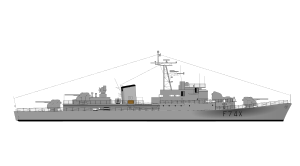French frigate Protet
 Commandant Rivière-class frigate | |
| History | |
|---|---|
| Name | Protet |
| Namesake | Auguste Léopold Protet |
| Builder | Arsenal de Lorient, Lorient |
| Laid down | September 1961 |
| Launched | 7 December 1962 |
| Commissioned | 1 May 1964 |
| Decommissioned | 1992 |
| Identification | Pennant number: F748 |
| Fate | Sunk as target, 2001 |
| General characteristics | |
| Class and type | Commandant Rivière-class frigate |
| Displacement | |
| Length | |
| Beam | 11.5 m (37 ft 9 in) |
| Draught | 4.3 m (14 ft 1 in) |
| Propulsion |
|
| Speed | 25 knots (46 km/h; 29 mph) |
| Range | 7,500 nmi (13,900 km; 8,600 mi) at 16 knots (30 km/h; 18 mph) |
| Boats & landing craft carried | 2 × LCP landing craft |
| Complement | 166 |
| Sensors and processing systems |
|
| Armament |
|
Protet (F748) is a Commandant Rivière-class frigate in the French Navy.
Development and design
Designed to navigate overseas, the escort escorts were fully air-conditioned, resulting in appreciated comfort, which was far from being the case for other contemporary naval vessels.
A posting on a Aviso-escort was a boarding sought after by sailors because it was a guarantee of campaigning overseas and visiting the country.
Four other similar units were built at Ateliers et Chantiers de Bretagne (ACB) in Nantes for the Portuguese Navy under the class name João Belo.[1]
All French units were decommissioned in the mid-1990s. Three ships were sold to the Uruguayan Navy.[2][3]
In 1984, Commandant Rivière underwent a redesign to become an experimentation building. It will retain only a single triple platform of 550mm anti-submarine torpedo tubes and all the rest of the armament was landed, replaced by a single 40mm anti-aircraft gun and two 12.7mm machine guns.
Construction and career
Protet was laid down in September 1961 at Arsenal de Lorient, Lorient. Launched on 7 December 1962 and commissioned on 1 May 1964.
In 1991, before the Operation Desert Storm, the vessel embarked additional equipment in Djibouti (Inmarsat, infrared camera, Mistral missiles, stealth tarpaulins, etc.). Until the end of the year, the embargo control missions alternate with stopovers (Kenya, Seychelles, Pakistan, Gulf countries). The last commander, Commander de Roquefeuil, takes up his duties in Djibouti during the month of May.[4]
In 1992, the previous year, the vessel carried out embargo control missions and several stopovers (Monbasa, Singapore, Colombo, Chittagong) before leaving Djibouti on Saturday June 13, 1992. It returned to Toulon on Monday June 22, 1992 for there start disarmament operations. Her last outing to the sea will take place on the occasion of the traditional outing of his commanders on Thursday, June 25, 1992.[4]
In 4,020 days at sea, this vessel will have circled the Earth 44 times, or approximately 960,000 nautical miles (1,780,000 km). She was decommissioned on 29 June 1992 and sunk as target off the coast of Toulon by a combined naval air force during a Trident exercise on 24 May 2001.[4]
Citations
- ^ "Navires". Mer et Marine (in French). Archived from the original on 18 September 2021. Retrieved 18 September 2021.
- ^ Gardiner and Chumbley 1995, p. 117.
- ^ "Aviso-escorteur Commandant Rivière". netmarine.net (in French). Retrieved 21 June 2015.
- ^ a b c "Historique". www.netmarine.net. Retrieved 18 September 2021.
